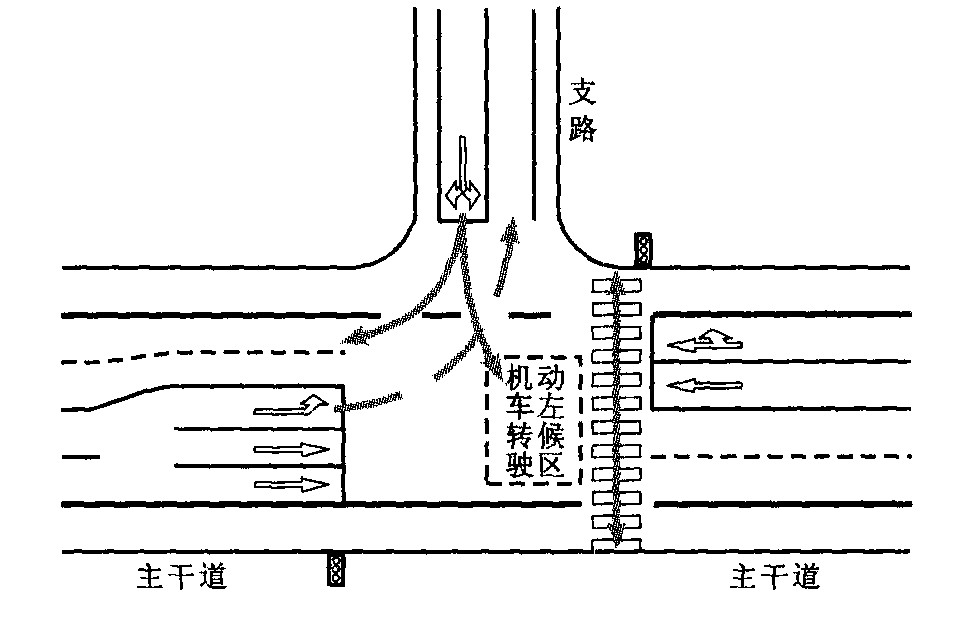Traffic Organization of Urban Arterial Road Intersected by Multi-Inferior Roads at T-Intersections
-
摘要: 为了对城市主干道与多支路T型交叉区域的交通进行合理的组织, 减少主干道与支路T型交叉口的交通流冲突, 降低主干道车流的延误, 通过对该区域的道路结构形态及交通分布特征的调查分析, 提出了主干道与支路接驳处渠化设计和主干道信号协调控制相结合的交通组织方式。与采用措施前相比, 该交通组织方式下主干道车流在T型交叉口处的单车平均延误降低了56.4%, 整体主干道单车平均延误降低了28.4%, 结果表明该方法是有效的。Abstract: In order to rationally organize the traffic in the area of urban arterial road intersected by multi-inferior roads at T-intersection, a traffic organization method with channelized traffic design and signal coordinated control was presented, based on the investigation and analysis of the characteristics of the above area.It is pointed that the average delay decreases of major-stream vehicles are 56.4% at T-intersections and 28.4% for overall arterial road segments respectively.The result indicates that the method is effective and convenient for the traffic organization in such areas.
-
Key words:
- traffic control /
- urban arterial road /
- T-intersection /
- inferior road /
- coordination control
-
表 1 信号协调控制设计
Table 1. Design of Signal Coordination Control
淮河路口/s 支路口a/s 支路口b/s 支路口c/s 义安路口/s 支路口d/s 信号周期 110 110 110 92 92 92 行人过街绿信时长 21 35 32 28 25 32 东西向绿信时长 55 75 78 64 46 60 机动车绿信号启动时间 以淮河路口南、北进口机动车左转相位开始时间为启动时间, 定义为t1 东西向机动车绿信号滞后淮河路口启动时间11 s启动, 定义为t1+11 s 东西向机动车绿信号滞后淮河路口启动时间3 s启动, 定义为t1+3 s 东西向机动车绿信号滞后义安路口启动时间24 s启动, 定义为t2+24 s 以义安路口机动车南、北进口直行相位开始时间为启动时间, 定义为t2 东西向机动车绿信号滞后义安路口启动时间15s启动, 定义为t2+15 s 表 2 平均延误比较
Table 2. Comparison of Average Delays
主干道方向平均延误 淮河路口 支路口a 支路口b 支路口c 义安路口 支路口d 建设路口 西至东 无控延误/s 36.4 15.4 16.9 19.0 36.5 15.3 37.1 信控延误/s 36.4 6.8 7.1 8.4 28.6 5.9 37.1 东至西 无控延误/s 24.5 15.5 16.2 19.2 34.2 15.8 40.0 信控延误/s 17.8 5.7 9.3 6.4 26.8 8.5 40.0 -
[1] 郑长江, 王炜, 陈淑燕. 行人过街信号与交叉口信号的协调控制[J]. 交通运输工程学报, 2004, 4 (4): 106-109. http://transport.chd.edu.cn/article/id/200404026ZHENG Chang-jiang, WANG Wei, CHEN Shu-yan. Coordination Control of Crossing Pedestrian Signal and Crossroads Signal[J]. Journal of Traffic and Transportation Engineering, 2004, 4 (4): 106-109. (in Chinese) http://transport.chd.edu.cn/article/id/200404026 [2] 黄文中, 杨佩昆. 无控制人行横道处的行人和机动车延误分析[J]. 同济大学学报, 1995, 23 (1): 31-36. https://www.cnki.com.cn/Article/CJFDTOTAL-TJDZ501.007.htmHUANG Wen-zhong, YANG Pei-kun. Delay of Pedestrians and Vehicles at the Nonsignalized Zebra Crossing[J]. Journal of Tongji University, 1995, 23 (1): 31-36. (in Chinese) https://www.cnki.com.cn/Article/CJFDTOTAL-TJDZ501.007.htm [3] 黄中伟, 庄焰, 谭也平. 城市车流加减速延误分析[J]. 深圳大学学报: 理工版, 2002, 19 (3): 60-64. https://www.cnki.com.cn/Article/CJFDTOTAL-SZDL200203011.htmHUANG Zhong-wei, ZHUANG Yan, TAN Ye-ping. Analysis for Acceleration and Deceleration Delay in Urban Traffic Flow[J]. Journal of Shenzhen University: Science and Engineering, 2002, 19 (3): 60-64. (in Chinese) https://www.cnki.com.cn/Article/CJFDTOTAL-SZDL200203011.htm [4] 李巧茹, 魏连雨, 马寿峰. 基于马尔柯夫过程的城市交叉口车辆到达模型[J]. 长安大学学报: 自然科学版, 2004, 24 (3): 53-57. https://www.cnki.com.cn/Article/CJFDTOTAL-XAGL200403013.htmLI Qiao-ru, WEI Lian-yu, MA Shou-feng. Model of Vehicles Arrival at Intersections Based on Markov Process[J]. Journal of Chang'an University: Natural Science Edition, 2004, 24 (3): 53-57. (in Chinese) https://www.cnki.com.cn/Article/CJFDTOTAL-XAGL200403013.htm [5] GB 50220-95, 城市道路交通设计规范[S]. [6] 东南大学交通学院. 铜陵市城市道路交通管理规划[R]. 南京: 东南大学, 2004. [7] 刘广萍, 裴玉龙. 信号控制下交叉口延误计算方法研究[J]. 中国公路学报, 2005, 18 (1): 104-108. https://www.cnki.com.cn/Article/CJFDTOTAL-ZGGL200501023.htmLIU Guang-ping, PEI Yu-long. Study of Calculation Method of Intersection Delay Under Signal Control[J]. China Journal of Highway and Transport, 2005, 18 (1): 104-108. (in Chinese) https://www.cnki.com.cn/Article/CJFDTOTAL-ZGGL200501023.htm [8] 杨佩昆, 吴兵. 交通管理与控制[M]. 北京: 人民交通出版社, 2003. -





 下载:
下载:








